Day 3
Tuesday, February 7, 2017
Well it wasn't raining this morning when we set out but it is not great. Dull and grey pretty much the whole day with the clouds only beginning to thin out towards the evening.
Breakfast was as per yesterday, that is, not really that memorable (except for the wonderful fried pancetta) and quite busy with visitors anxious to head out for the day. The hotel lobby is not quite as busy as yesterday.
I had been thinking it might be interesting to go around the outside of Venice this time rather than back down the Grand Canal as we did last night. There are vaporetti routes the head away from the hotel past the port area and where the cruise ships come in so it might be an interesting place to pass by, well, at least once. To get to the vaporetti to go on this route we had to once again cross over the bridge near the hotel.
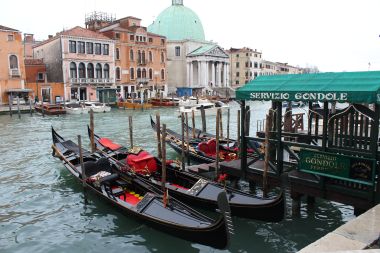
We stopped for a few minutes for Mel to get a picture of a man pushing a cart over the bridge - Ingeniously there was a small wheel sticking out from the front that could be leveraged to get the cart up each of the shallow stairs.
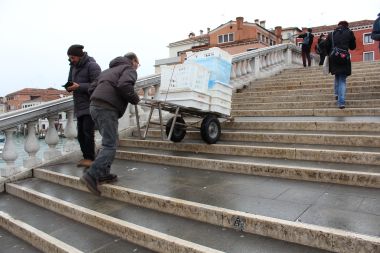
Just before getting to the vaporetti station I noticed there was a church here whose facade is undergoing maintenance and covered with scaffolding but it might be nice to have a bit of a look at something more local. “Santa Maria di Nazareth (Chiesa degli Scalzi)” (1680) is a local church but is still quite impressive. The small, dark but ornate interior somehow felt very warm and inviting. The walls were a mottled marble with gold embellishments and corkscrew pillars around the alter. The simple pews laid out on the checker-board marble floor belied the beauty all around. Paintings and statues everywhere but it all seemed to work and come together as a coherent whole.
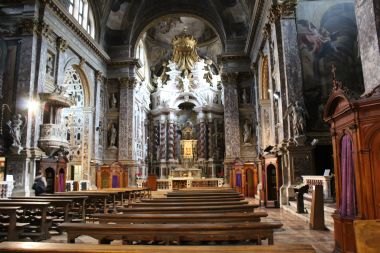
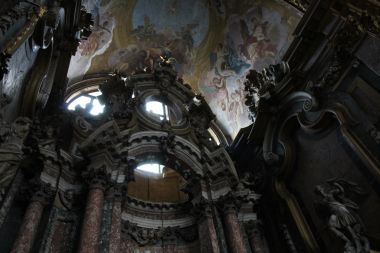
As I was admiring all of this I noticed a couple of policeman enter and talk to the caretaker who led them over to a blank picture frame and starting talking to them. I fear a picture may have been stolen.
Mel was busy, as was I, taking pictures of everything but focused in on some small details as we left the main part of the church - pieces of colourful inlay work in the wooden doorways and marble patterns on the floor. Sometimes she spots things my eyes just skip past and it forces me to stop and take a closer look.
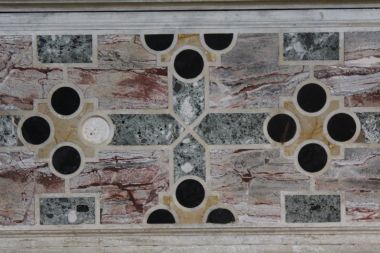
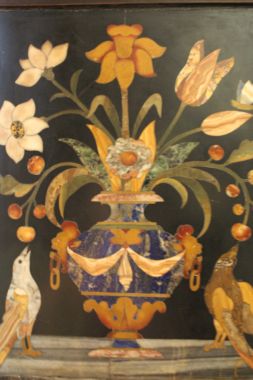
The exit was through the gift shop which I can't blame them, really, they have to make money to pay for the what must be huge bills to be paid here. Copious amounts of holy water in bell-shaped plastic bottles with blue lids were on sale for €1 as well as other typical church merchandise (crosses, religious books, etc) but there seemed to also be a large amount of organic cosmetics available as well for some reason…Anyway, we left the church and found ourselves outside of the train station right beside the vaporetti station (Ferrovia) so we touched our way onto the floating platform to wait for the boat (route number 2).
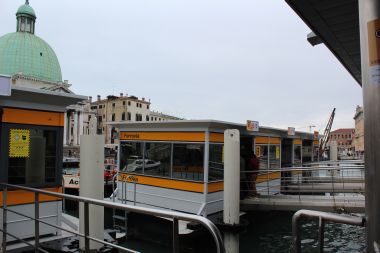
Compared to last night the boat was a lot less busy and we grabbed seats outside near the bow of the boat. As we passed by the hotel then the bus station where we arrived on Sunday we very quickly entered quite an industrial area first with a set of loading docks where trucks were pulled up to the edge of the water with their contents loaded onto small barges for their trip into the city. It was interesting seeing the small narrow boats piled high with boxes - every space available covered with cargo. Quite a small area but I imagine it is always busy.
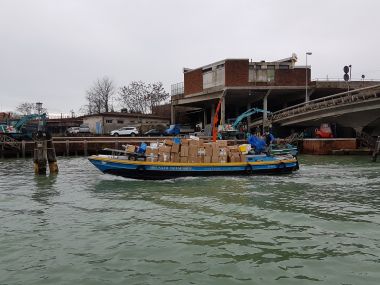
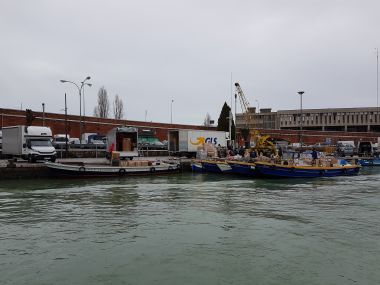
A modern winding bridge looking like the bones of a spine passed over the canal near the “Mercato” stop. We saw a small train passing over this bridge taking people from a large car park outside the city (where you must park as cars are not allowed in Venice) on the small artificial island of “Tronchetto” to Piazzo Roma, the entrance to the city where the bus station is located (where we arrived on Sunday) and where you can access the train station and vaporetti easily. After not seeing any transport other than boats it was a bit of a change…
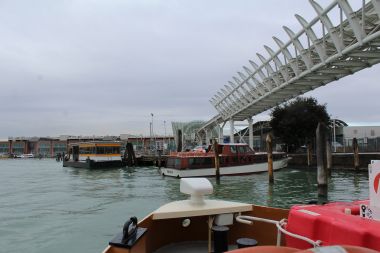
The vaporetti now took us into the obviously industrial area of the city with large expanses of water, warehouses and docks on either side with a beautiful view into the open water to the west of the city and, today, a patch of clear sky on the horizon. We passed by the large piers for the cruise ships which are empty this time of year. Absolutely enormous but quite nice looking. It is a bit of a trek from here, I feel, into the city but no doubt there are vaporetti that move the visitors about. The waves here are a lot higher as well as we continued along down the west the along the south side of Venice between the “island” of Guidecca and the central area of Dorsodoru. There was a lot of commercial traffic here with small barges going to and fro but not a lot of tourists. We even saw a few car ferries operating here. It is good to see the working side of the city with people on the shore obviously going about their daily business shopping, going to school or going to work.
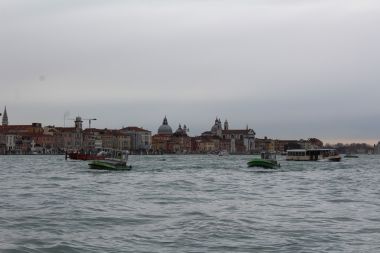
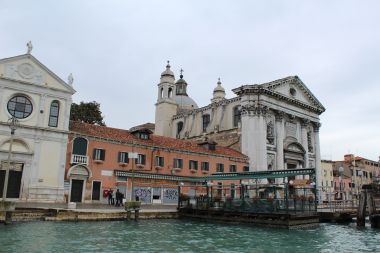
As we continued the vaporetti alternated from stops on Guidecca to stops on Dorsodoru with the city noticeably ageing the closer we got to San Marco. Soon enough the easily recognisable Campanile tower was visible poking up from the city.
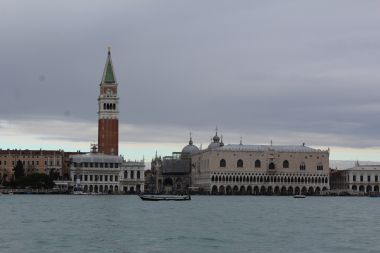
The vaporetti pulled into the church directly south of Piazza San Marco, the “Chiesa di San Giorgio Maggiore” on a small island just off the eastern most tip of the crescent shaped Guidecca. It is home to both the impressive church but also a (former) convent and, to the back, a small outdoor amphitheatre (“Teatro Verde”). As it was away from the tourists and the area of the city we had already visited we decided to get out and have a look around. The facade is quite imposing with massive white pillars and a large black door.
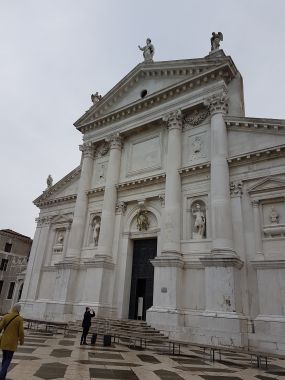
The interior is surprisingly spartan with the space speaking for itself. A simple checker-board floor with more columns supporting the ceiling and a large dome in the middle.
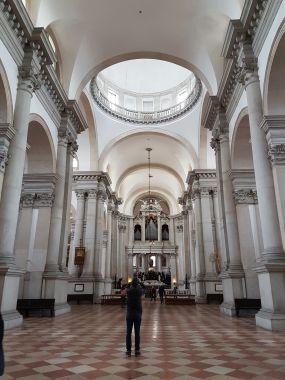
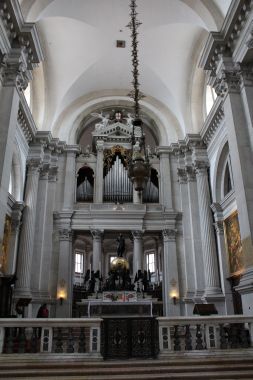
We had thought a trip up the tower would be a good way to see San Marco and the rest of Venice so made our way around the interior to the entrance. It was surprising to see some modern art here but it is a reminder that this is not just a museum but church still in use today with modern sensibilities.
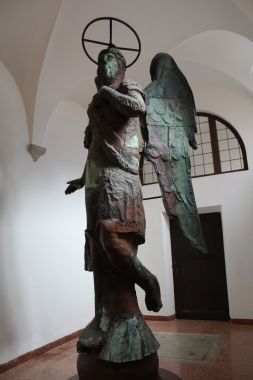
There was a small fee to go up the tower (paid for in a nicely heated ticketing area - it is cold today!) which we paid then made our way up. The views here are spectacular not only the heart of Venice but also of the islands in the lagoon including Guidecca and the long needle-like Lido to the south east where most of the resorts (yes resorts) are located (yes with beaches). There are also a surprising number of other smaller islands we could see here that we really could not see from Campanile. It actually gave us a better understanding of the place - There really is a lot of water here with much larger expanses between the islands than I would have expected. You can see how much people are reliant on boats to get around with the many scattered islands all around. Below us we could see a small marina with a number of small sailboats then on the other side we looked down into the old convent grounds and gardens that look immaculately maintained with a wonderful looking maze. Google tells me the old convent is now a “…cultural institution hosting art and other exhibitions…” We could see along Guidecca as well which, surprisingly given how close we are to the centre of Venice, had a number of hotels with swimming pools. I guess when you get away from the main island you have the large hotels/resorts.
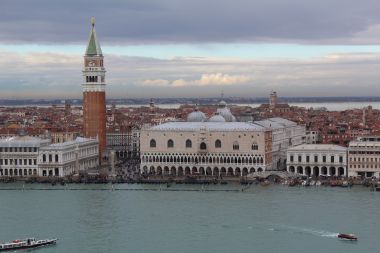
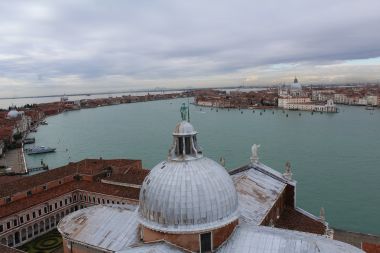
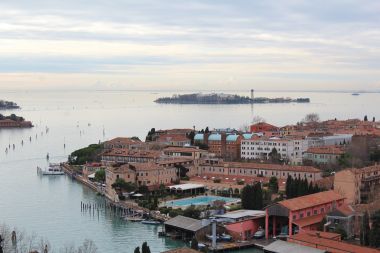
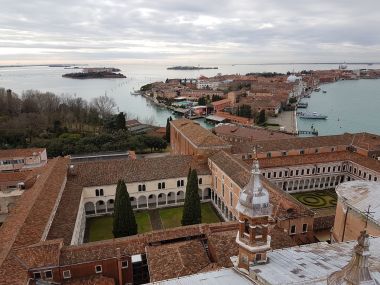
Remember yesterday my talking about waiting for the bells at the top of the hour and not hearing them in Campanile? Well, as we entered the tower we were warned that the bells would sound at the top of the hour…so we waited! Just like in Campanile this is the bell tower with the bells only a few feet above our head with small ones and very large ones. All of them made quite a racket when they eventually started sounding…but not as loud as you might think.
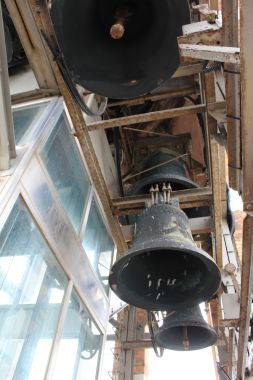
Returning to the church we continued a look around the church by visiting the choir and altar area. Here it was much more ornate than the rest of the church with the simple checker-board floor now a wonderful multi-coloured geometric mosaic of marbles.
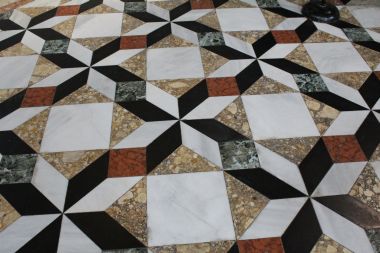
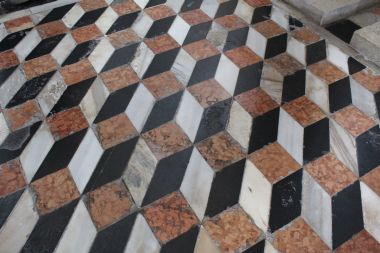
Two huge paintings on either side of a massive classical sculpture of men pushing up a huge gold ball with, presumably, a saint standing on top.
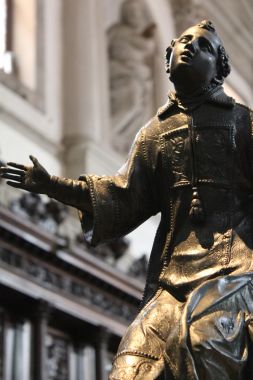
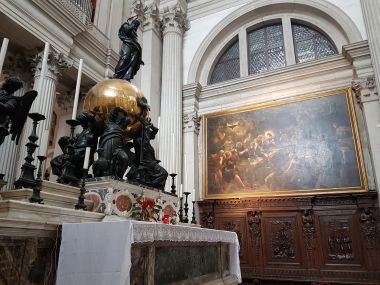
Back outside we admired the clear view across the water from the small square in front of the church. San Marco and the skyline of the heart of Venice with boats darting here and there. It is quite peaceful here so we were not in any hurry to leave.
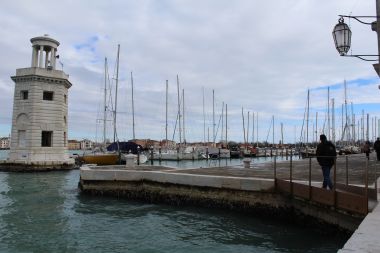
We continued around the back of the church passing by the marina (stopping only to allow Mel to take pictures of birds) then around to see the amphitheatre I had heard of but as we walked along the back fence it was clear it was locked up for the season. Shame. As we returned around to the front there was a small cafe hidden at the back of the church so we decided to warm ourselves up a bit inside.
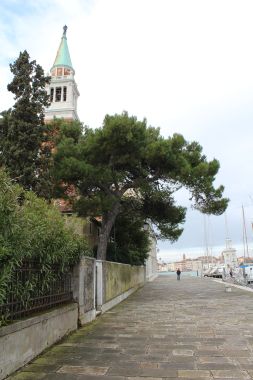
The small cafe only seated perhaps 15 or 20 people with a few already having something to eat and drink inside. The small counter had a number bowls and plates with food to choose from. It looked great to me so I ordered a few things (it was, after all, lunch time) while Mel was happy to just have a coffee. The dishes were all, of course, home made today so I picked a wonderful egg-plant/cheese dish similar to a lasagna but without the pasta (if you can imagine) - It was glorious. Full of flavour and zest. Delicious.
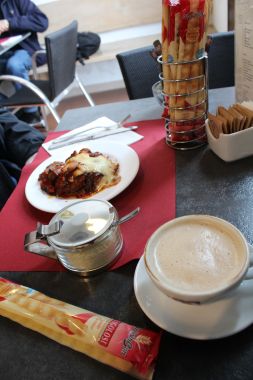
I could see sitting in the plain but very comfortable interior of the cafe for a long time but we had places to go, things to see, so I visited the spotless (huge) toilet that was incredibly hot (with the door shut the heat stays in I guess) before we headed out…
It was not that long to wait for another vaporetti to pull into the stop outside the front of the church which took us straight across “Bacino di San Marco” to the San Marco stop (just one stop!).
Having wandered around the square yesterday today we decided to visit the ornate “Basilica di San Marco” (Saint Mark's Basilica) the reasoning being that the Doge's Palace we thought sounded more like a museum. They are obviously prepared for large numbers of visitors here with large signs about no photography and a (fairly) strict policy about no backpacks (rucksacks) inside the building. As it was my turn carrying Mel's rucksack I was not allowed in and directed down a back alley off of the square to a small church where they were set up as a “coat check” for the Basilica. It was a bit of an annoyance but not that bad as at least I did not have to carry the bag! I struck up a small conversation with one of the attendants while I was there when he asked where I was from and what I had seen…
I passed under one of the arches in the front of the church but this time brandishing my bag claim chit I was allowed in. The church is incredible inside with every inch seemingly covered with gold. It is not a huge building by any stretch. The ceiling is a series of domes (again, yes, covered in gold).
There was no entrance fee to get into the basilica but they did charge us to see some of the more interesting areas of the church including the treasury where we paid €5 each to enter. This was probably, for us, the oddest part of the visit with a large number of relics on display - Various body parts from saints that are believed to offer spiritual or physical healing - Held in the most ornate containers. There was a small room wrapped in a display case with many of what many would agree are quite macabre artefacts. We made our way around reading the small labels (thankfully most in English) telling us what each piece was. The rest of the treasury is what you might expect with massive crosses, bowls and the like of gold and various precious stones.
Returning to the free part of the church again (!) we paid another €3 each to see the “Pala d'Oro” (“gold blade”) altarpiece - 250 gold panels encrusted with stones. Quite impressive.
Despite the signs everywhere about no photography we noticed that people were sneaking pictures everywhere so I took the opportunity to ruin a few shots being taken of the altarpiece by standing in front of the camera, perhaps a slight jolt to the arm as I walked by…etc. Petty, absolutely, but it really annoys me - We were following the rules yet others just ignored them completely. As far as I am concerned I am a visitor and I abide by the rules of where I am out of respect. Ok, done my slight rant now…
The absolute highlight of our visit was when we climbed up the narrow, and very steep, staircase up to the museum located above the front entrance which gives access to the front portico as well (at €6 each it was the most expensive but worth every cent if you ask me). After passing through a somewhat tacky souvenir shop (we paid to get into a shop???) we were shown scale models of the basilica then we were in an area right above the main (middle) front entrance looking into the heart of the basilica. Incredible view being higher up, close to the ceiling where we were able to better appreciate the space than from the ground. At this point we decided to go out onto the balcony which was quite interesting - Above the entrance arches between the crowning statues and the mosaics below the roof-line surrounding the exterior. Great view of the square but also a close-up of the wonderfully intricate mosaics. Here we were walking on what is, of course, a roof stepping onto the stone slopped to drain away water. We were able to walk the full length of the front facade but also around to where the Basilica joins up to the Doge's Palace where there was a bit of scaffolding put into place for conservation work. Everyone was snapping pictures of everything - Probably the best place to get pictures of Piazza San Marco as you can really appreciate the size and beauty of the place. We spent some time just leaning on the banister watching the crazy tourists in the square feeding the pigeons in scenes much like what you might have seen in “The Birds”. It is a great place to people watch.
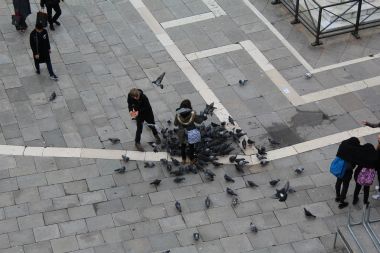
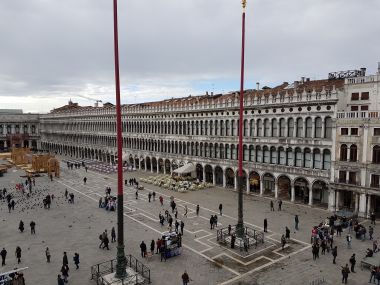
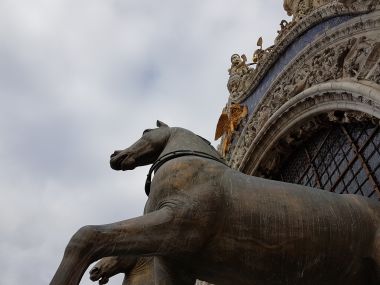
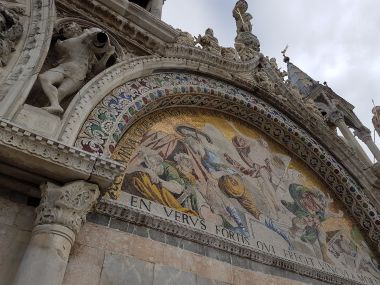
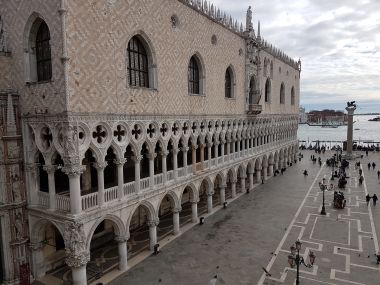
Returning back inside we continued our tour of the museum area and I was delighted to find a large exhibit of art from the church (after first going down a narrow set of steps, up another set of steps, past the ceiling mosaics on the ceiling in the north aisle - so close you could touch them - but don't!, then around to the back) in a large room. Here there were large tapestries, vestments, statues and the like. Quite nice to be able to see them up close and in a somewhat quieter, more appreciative, atmosphere than the main body of the church (no pictures!).
I had not really read the tourist book a lot but I did notice something that I found interesting outside of the normal tourist attractions here and that was “La Fenice” (“The Phoenix”), Venice's oldest theatre which now shows only opera. Now was the time to go searching for it. Leaving the church we knew it was, basically, due west of San Marco so we just started walking that way following the narrow alleys as they twisted this way and that, going over small and not-so-small canals, turning sharply to force us on a diversion for a while before being able to once again head in the general direction…This approach seemed to work and a short while later we were rewarded with the unmistakable facade of the theatre - A large rectangular building with four pillars in front of the entrance and flags lining a balustrade above. Hanging between the columns the figure of a gold phoenix with the sign for the theatre hanging in it's talons. Sounds great but all-in-all it was rather plain looking.
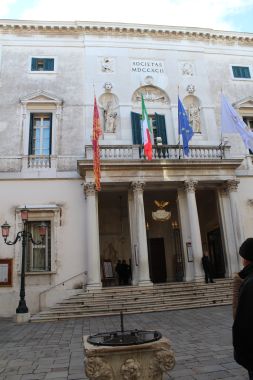
I was not entirely sure the place was open but pushing on the doors we were happy to see they opened into the wonderful entrance hall…or, rather, the ticket and souvenir shop in the corner of the entrance hall. I had done my research and knew there were self-guided (paid) tours and that we would have to pay to use our cameras so we paid our €10 each for the audio guide and we paid the camera fee for Mel (I wanted to just soak it all in - the first European opera house, outside of the UK, I have ever visited).
The foyer of La Fenice is elegant simplicity itself with light pink marble columns and floors with slightly OTT chandeliers hanging from the ceiling. Ever obedient, we followed the directions of our audio guides and found a seat to listen to a brief history of the building. It was amusing to hear that “La Fenice” is very aptly named having burned down and been rebuilt several times, most recently the house was burned down in 1996 to be rebuilt and opened again in late 2004. In rebuilding they took great care to restore the building as much as possible to how it was before but I was happy to hear they incorporated a number of modern features when rebuilding including a climate control system that directs air directly under the seats to avoid having a large noisy venting system controlling the temperature.
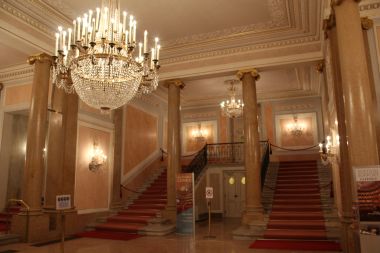
Following the directions of the audio guide 10-15 minutes later (ok, it seemed like a long time) we walked up some steps into the interior. Incredible. It is everything that I imagined in a European opera house - The magnificent gilded arch of the stage with five levels around the interior of the theatre containing separate seating compartments and the double-height “royal box” right in the middle immediately opposite the stage (where it should be rather than off to the side as we see so often in London Theatres - great for the audience to see the famous people but rubbish for the famous people to see the show). The round ceiling is incredible - A simple yet elegant chandelier hanging from the middle with a simple pattern covering most of the space accented with a few, small painted figures. Over the top, yet not over the top at the same time - This is classy baroque, not the stuff you see in tourist shops. Sitting down to listen to the guide we were told that the ceiling despite looking domed is, in fact, flat and was the only element of the auditorium that was created on site.
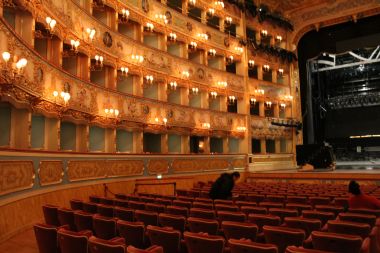
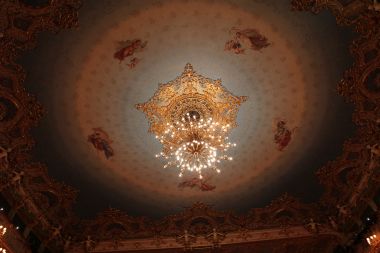
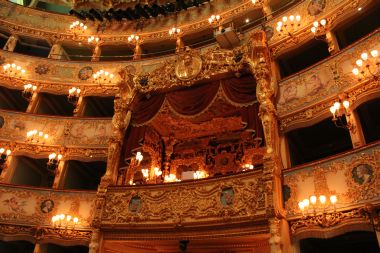
Obedient to the voices of our electric overlords we headed up the stairs on the outside of the auditorium to the incredibly ornate royal box complete with “infinity mirrors” (two mirrors facing each other) that give the illusion of a much large space yet also keep the space quite light and airy. The view of the stage is amazing from here though today it was largely a big empty space that stage hands were preparing for a show (before our trip I had looked into attending a performance here but the only performance was on Sunday - the day we arrived - so I did not want to run around after all of that travel!). I have to say sitting in the royal box really gave you the feeling of being very special indeed. It is a royal box worthy of the name. Little details such as hand painted panels amongst the gold filigree really made the space amazing.
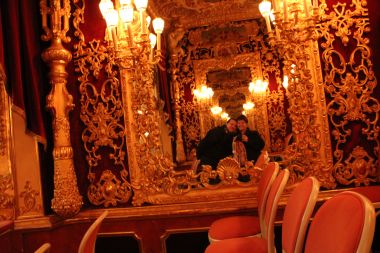
Leaving the royal box we passed by the doors to the various seating boxes around the auditorium making it feel almost like a hotel. A nice hotel with doors very, very close together, but a hotel nonetheless. Maria Callas played many times at La Fenice so we visited a small exhibit about her performances here (I was interested but Mel not so much - I am the opera fan). The final portion of the tour took us through some of the halls that are rented out for talks and used for refreshments. No where near as impressive as the auditorium but still very nice indeed.
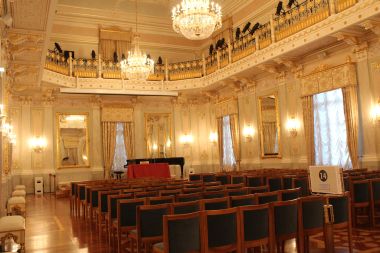
La Fenice a huge theatre seating only 1,000 people but it makes up for in sheer beauty. The Royal Opera House in London (seating 2,256) could learn a lot from La Fenice - True class.
Damn, I have to get tickets for the opera next time I am in town.
One thing we had learned on the tour was that a particular requirement when building the theatre was that there needed to be an entrance on the water so that the aristocracy could arrive without having to mingle with the unwashed mere mortals of the city so we went off in search of the back entrance which, of course, still exists (and is still used) on a purpose-built canal.
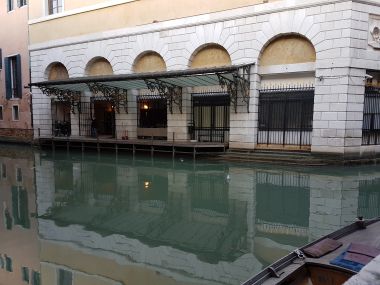
Ok, damn (again), now, I have to remember to arrive by canal when I get tickets for the opera next time I am in town…Might be an expensive evening but, hey.
Watching the canals behind La Fenice we heard some music then saw a gondola with several Chinese tourists in it being serenaded by an accordion player and a singer. The first musical gondola we have seen here (remember: Gondoliers do NOT sing).
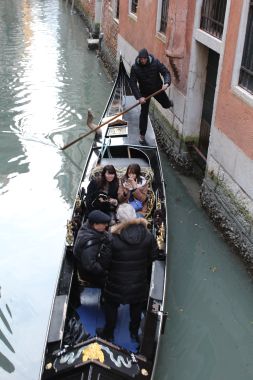
The next destination we though of in the area was the Academia bridge over the Grand Canal. Mel had highlighted this in the tour book so we again headed, roughly, west in search of the bridge (there are only a few bridges over the canal so it would be difficult to miss). In a large square we came across a music museum (Museo della Musica) housed in an old church so decided to have a look (free!). It had a large number of violins and other stringed instruments by famous craftsman. No, no Stradivari (?)…Stradivarius…Stradivariuses (?) – I checked. It was interesting the number of master craftsmen that made these beautiful instruments though I have to admit I recognised not a single name. One corner of the museum they had done up like an instrument maker's workshop showing how the instruments were constructed which I found interesting though I also liked seeing some of more unusual instruments here.
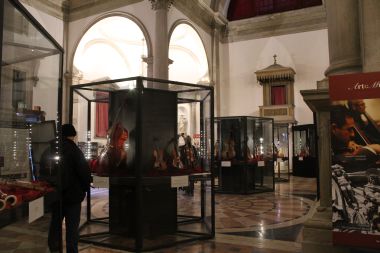
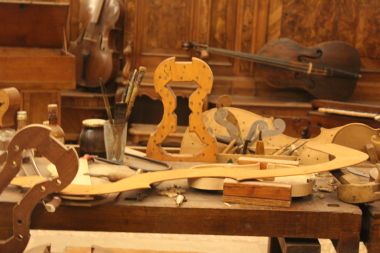
Getting to Academia from here proved to be quite straightforward: Simply a matter of following the crowds, sticking to the larger alleyways and courtyards. A rather plain looking church we passed had a sign posted out front about a Vivaldi (a native of Venice) concert in the evening but we were allowed to look inside (or even visit though we were not bothered). I have noticed that here in Venice there are daily Antonio Vivaldi concerts typically held in any one of a number of churches he was known to have performed in. Most of the time these concerts will include Vivaldi's most famous work, “The Four Seasons”. I am not terribly interested in these sort of “light classical” concerts aimed at tourists particularly when I can see more authentic and, potentially, accomplished performances elsewhere (sorry, a bit of a snob), however, if we had been here longer I would have considered going one evening (I am not THAT much of a snob!).
Eventually we came to the entrance to the Academia bridge in the corner of a square with a gondola station right beside the bridge on one side that we used to try to get a view of the bridge that was otherwise obstructed. There were a number of gondoliers touting for business but they did not approach us though I am not sure why, perhaps they thought we did not have any money or, more likely, they saw that we were not really showing an interest in taking a trip. A small cluster of bushes and trees beside the station had a strong smell of urine and was obviously a “pit stop” for either the gondoliers or other locals.
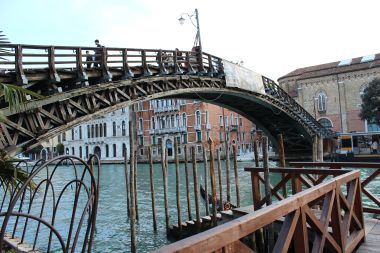
The Academia Bridge (Ponte dell'Accademia) is one of only four bridges across the grand canal and is unique in that it is the only wood bridge. It is surprisingly intricate and allows pedestrians to cross from the centre of the city (San Marco) into the Dorsoduro section which is decidedly less busy, more residential. The views of the canal from the top of the bridge's arc are amazing as the canal is quite wide here - You can see the domes of churches towards Saint Mark's square to the east and the gentle bend of canal as it continues to the north towards Rialto.
In our tourist book I had read about one thing in particular that I wanted to see in Dorsoduro and that is a boat selling vegetables so we went off in search of it. A quick check in the book showed that the boat was beside the “Ponte dei Pugni” on the San Barnaba canal. We made our way north-west where the map indicated the canal could be found passing through a much cleaner and more spacious area of the city. Here the paths are wider and things look not quite as old. Eventually we found the canal and saw the boat just to our left moored alongside. The boat is quite amazingly stocked with fresh fruit and vegetables, obviously very popular with locals and tourists alike though I can imagine many people would have problems even finding it. I am told the boat is a bit of a local institution…
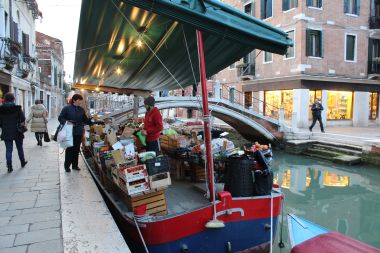
The small canal is quite quiet compared to the areas of the city we have visited so far so we went for a walk along it's length until the path ended so we could go no further, were forced to cross over the canal by bridge. The canal is quite pretty with numerous boats obviously owned by locals tied up alongside with the buildings of various styles, shapes and colours, on either side. There are a few shops here which are either boutiques or local grocery stores. We had in mind a restaurant we had found in the books near St. Mark's square so we headed back to the grand canal to catch a vaporetti passing through a large public square (Campo Santa Margherita) that was obviously used by local people with children playing, people walking here and there as well as restaurants and cafes on the sides - A slice of Venetian life away from the tourists.
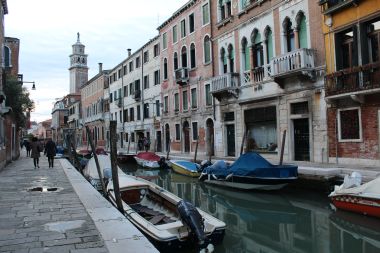
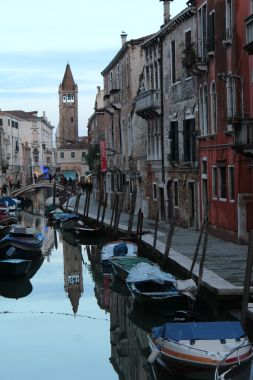
We caught the vaporetti from a small stop along the grand canal, Ca' Rezzonico, back to St. Mark's. The restaurant is located on the second side canal to the east of St. Mark's so was relatively easy to find though without precise street names and numbers it is always interesting here (general directions works well). “Trattoria alla Rivetta” (see my review here) is a small restaurant much lauded by the tourist books though with mixed reviews online with many complaining about “brusk” service and a busy interior though not often about the food itself. It is on the end of a small alley before is crosses over and equally small canal so would be fairly easy to miss were it not for the large street light with it's name on it hanging over the alleyway.
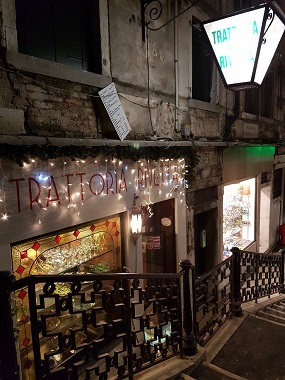
The restaurant itself was small with a bar on our left as we entered into the front room, crammed with tables and people, the walls lined with pictures of local sporting events as well as more tacky plastic flowers on other decorations - It looked like just a local place to eat rather than something “fancied up” for tourists (thankfully). We were shown to a room at the back and a table against the far wall so had a good view of pretty much everything throughout our visit and I could hear people passing along the alley just on the other side of the wall through a blocked-off window. The waiter, yes, was a bit brusk but was efficient and honest with us. We had a great, relaxing, time but I could see other tourists trying the patience of the staff as they seemed not to have ever seen an Italian restaurant menu before (yes it was in many different languages helpfully with an appropriate flag at the top of each column). It was very good and not very expensive. I am glad we looked it up though as I can see you could very easily go wrong here (by “wrong” I mean being ripped off with non-authentic food for a lot of money something like what I felt last night).
On leaving the restaurant we spent some time trying to take pictures of the awkwardly placed restaurant before heading to St. Mark's for the vaporetti trip back to the hotel. This is the first time we have seen the heart of Venice at night and it was beautiful seeing the buildings lining the canal lit up and their reflection in the water.
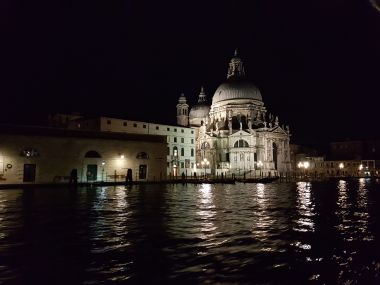
At the Rialto Bridge stop we heard an approaching siren then a few seconds later an ambulance boat, ignoring the canal speed limit, racing at full speed, making large waves as it passed under the bridge towards us on it's way to an emergency. Quite a bit of excitement after the rather quiet days we have been having! The wake of the boat rocked the vaporetti and the sides of the canal for a long time afterwards.
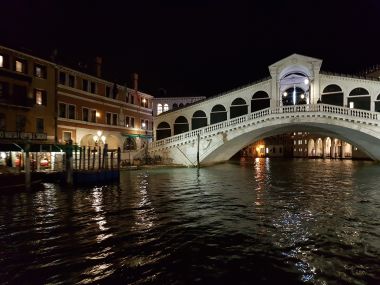
Back at Ferrovia at just after 8 pm we made a diversion to the Magnum shop where Mel was VERY keen on trying a “custom ice cream” treat. For €5 she was able to pick from a number of toppings which the server placed on top of the ice cream bar. It was all a bit messy so it was served in a small cardboard tray though Mel did not seem to mind!
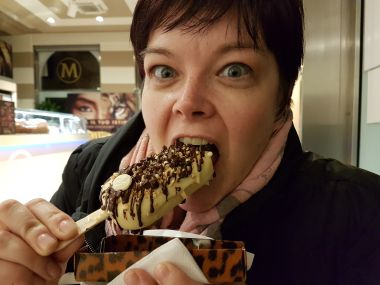
Another full day today so it is nice to have a bit of a relax at the hotel though we are still making our way through the pizza we bought on Sunday night (yes it is still very tasty!). I love it on holidays when you are sitting on the bed in the hotel room eating junk food and just generally chilling out. Tomorrow we are thinking of a bit of travel to another area of Venice we have not yet seen: Murano, home of the famous Venetian glass.
⇒ Day 4